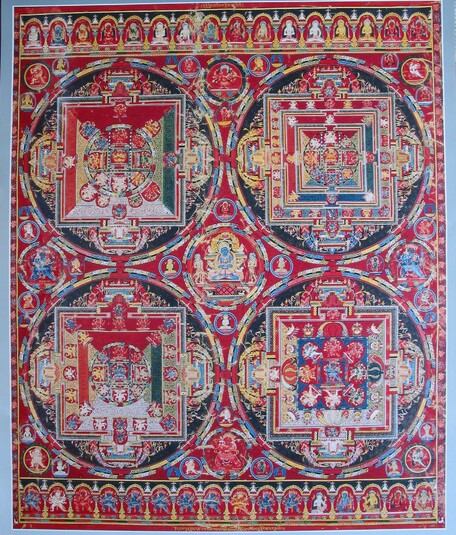
Item: Mandala of Guhyasamaja (Buddhist Deity)
| Origin Location | Tibet |
|---|---|
| Date Range | 1400 - 1499 |
| Lineages | Sakya, Ngor (Sakya) and Buddhist |
| Material | Ground Mineral Pigment on Cotton |
| Collection | Publication: Wisdom Publications, Calender |
| Catalogue # | collection of Musee Guimet Museum, Paris |
Classification: Deity
Wisdom Calendar 2001 - December (full catalog list)
This painting contains four mandalas. The top two and bottom left mandalas are of the three forms of Guhyasamaja; Akshobhya, Manjuvajra and Lokeshvara. (See HAR #200624).
Akshobhyavajra Guhyasamaja Description: "...with a body blue in colour like sapphire, issuing forth rays of blazing light. The main face is blue with a mixed expression of fierceness and desire. The canine teeth are pointed and clenched, frowning and having three eyes. The right face is white in a peaceful manner, left face is red in a desirous manner. All three faces are adorned with very beautiful eyebrows. Each of the six hands are adorned with precious rings. The first two hands hold a nine pointed vajra and a bell embracing the consort [who is in] the same [appearance] as the [Father]. The right second [hand] holds a white wheel with eight spokes. The third [hand] holds a red lotus with eight petals. The left second [hand] holds a green jewel with nine facets. The third [hand] holds a sword, bright blue and blazing with rays of light. Seated with the legs in vajra posture, adorned with the thirty-two major and eighty minor marks, the hair, in braids, is tied on the crown of the head. The jewel on the crown of the head greatly blazes with soothing rays of light [like] the sun and moon. Adorned with eight [different types] of precious ornaments: a crown, earrings, choker, necklace, armlets, bracelets, long necklace and belt. The ears are made more beautiful with blue utpalas and ribbons; wearing various [heavenly] garments bright like Indra's bow [rainbow]." (Jamgon Amezhab, 1597-1659).
"...Manjuvajra, with a body the colour of purified gold, three faces and six hands. The main face is yellow, the right blue and the left white. The first two hands embrace the Mother. The lower right hands hold a sword and arrow, and the lower left an utpala [flower] and bow; wearing jewel ornaments and having the thirty-two major and eighty minor marks; seated with the legs in the vajra posture. In the lap is the Mother Manjuvajra with three faces and six hands, with the colour, hand objects and embrace, the same as that of the Father. Both are resting in a state of union and emanating forth rays of light." (Written by Jamyang Khyentse Wangchug, 1524-1568 reference).
The Guhyasamaja Lineage of Jnanapada: Vajradhara, Arya Manjushri, Acharya Buddha Jnana, Marmedze Zangpo, Shri Deva, Vimalagupta, Ratnavajra, Ratnakirti, Lama Pendapa, Lama Nyen Lotsawa, Lama Nang Kaupa, The Lord of Dharma Sakyapa (Sachen Kunga Nyingpo 1092-1158).
Jeff Watt 10-2005
Front of Painting
English Translation of Inscription: There are inscriptions on the top and bottom margins of the painting.
Mandala: Mandala Main Page
Mandala: Four Mandala Composition
Mandala: Painting Composition Types (Number of Mandalas)
Tradition: Sakya Deity Paintings
Buddhist Deity: Guhyasamaja, Manjuvajra (Mandala Masterworks)
Buddhist Deity: Guhyasamaja Main Page
Mandalas: Sakya Tradition
Buddhist Deity: Guhyasamaja, Manjuvajra Main Page
Buddhist Deity: Guhyasamaja, Akshobhyavajra
Buddhist Deity: Guhyasamaja - Lokeshvara
Buddhist Deity: Guhyasamaja, Akshobhyavajra (Mandala Masterworks)
Mandala: Religious Context
